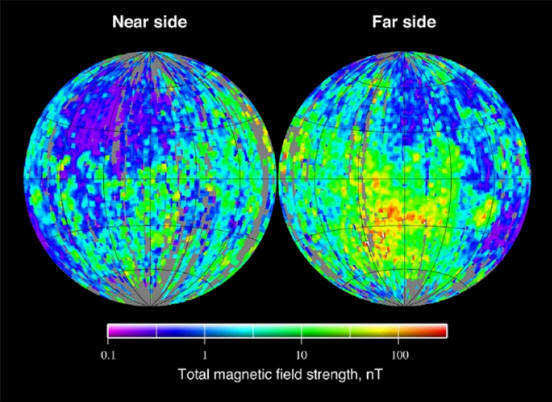Recent lunar
missions have uncovered new
information that changes the way we
look at the Moon.The Moon is
a "dead body," according to modern
theories of the Solar System; it
long ago exhausted any remnant heat
that it retained from its birth. It
has no intrinsic magnetic field and
it does not radiate, except to
reflect the light that it receives
from the Sun. But could electrical
forces have recently shaped the
lunar surface?
The discovery of water ice at the
south pole buried beneath the walls
of sun-shaded craters was one of the
more important new finds of the past
few years. Latent
magnetic fields were detected by
the
Lunar Prospector spacecraft in
the 1990s. Evidence from that
experiment points to a variable
strength magnetic field imprinted on
the Moon, and magnetism is a result
of electric currents.
Recently, scientists from NASA's
Lunar Science Institute’s Dynamic
Response of the Environment at the
Moon (DREAM) project
announced the discovery
of electric charge in some of the
polar craters. According to William
Farrell of NASA’s Goddard Space
Flight Center: "....in addition to
the wicked cold, explorers and
robots at the bottoms of polar lunar
craters may have to contend with a
complex electrical environment as
well, which can affect surface
chemistry, static discharge, and
dust cling.”
It is thought that the solar wind
might be what charges up the craters
to many hundreds of volts. Computer
simulations led the researchers to
believe that the solar wind acts
like winds on Earth. Depending on
temperature, winds flow into cold
valleys. On the Moon, the solar wind
flows down onto cold crater floors.
As their theory states,
electrons, having less mass, flow
into a lunar crater before the heavy
ions, forming a negative charge. The
heavy ions move into the crater at a
lower pressure then the electrons,
causing the interior walls and floor
to become negatively charged. Charge
separation is greatest along the
crater rim closest to the solar wind
flow.
The article suggests that
"....the heavy ions have the
greatest difficulty getting to the
surface. Compared to the electrons,
they act like a tractor-trailer
struggling to follow a motorcycle;
they just can’t make as sharp a turn
over the mountain top as the
electrons." Planetary scientists
relate electric current flow with
kinetic illustrations once again.
Between May 1966 and January
1968, NASA launched the
Surveyor spacecraft,
which soft-landed on the lunar
surface. Surveyor 7 made one of the
mission's most intriguing
discoveries when its onboard camera
detected a faint glow in the lunar
night, hovering over the horizon.
In 1998, the
Lunar Prospector detected
a surprisingly high voltage change
as it passed through Earth's
magnetotail. The magnetotail is part
of a plasma sheath that envelops our
planet. The Moon passes through it
once a month during full moon phase.
The electric differential was found
to occur during that passage.
The Earth is surrounded by a
magnetic field that is trapped
inside a cometary plasma tail that
stretches well beyond the Moon's
orbit. The Earth's magnetospheric
tail points away from the Sun due to
the high-speed ions streaming along
with the solar wind. The movement of
the Moon through the ionized plasma
affects the materials in the lunar
regolith. Electrons accumulate and
produce a negative charge on the
ultra-fine dust particles, causing
them to repel each other and drift
off the surface. The levitating dust
and the faint glow on the lunar
horizon are most likely because the
Moon has no atmosphere at all, so
the electric charges have greater
impetus.
Charge differential between the
day and night side of the Moon might
generate an ion “wind” flowing from
the negatively charged night side
into the more positively charged
sunlit side. The negative charge on
the bright surface during daylight
is moderated by the photoelectric
phenomenon, while it tends to build
up in the darkness, forming static
electricity. The charge variation
between the two hemispheres has been
measured at more than 1000 volts.
Electric Universe pioneer
Ralph Juergens explained
the structure of Tycho Crater on the
Moon in electrical terms:
"The visual evidence suggests
that triggering electrons for the
Tycho discharge were assembled by
means of an atmospheric-breakdown
process that drew them from numerous
distant points in all directions and
hauled them over the surface to a
common collection point. On the far
side of the Moon are several more
long-rayed craters, presumably
marking sites where much the same
thing happened; these, too, are
located in highland terrain."
Earth's cometary plasma cocoon
changes shape and power as electric
currents from the Sun bombard our
planet. It is sometimes described as
a “flag waving” because of somewhat
regular oscillations in the field.
This means that the Moon does not
simply pass through the magnetotail
once and briefly, but that electric
charges will brush the surface
several times during each monthly
encounter.
Stephen Smith







